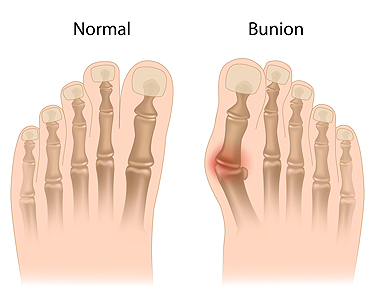 The medical condition known as hallux valgus is commonly referred to as a bunion. It typically occurs as a result of a misalignment in the joint of the big toe, and may cause pain and discomfort. It appears as a large bony protrusion on the side of the big toe and may be difficult to wear specific shoes. If you have a bunion, you most likely may notice tenderness and swelling around the affected joint, in addition to possible joint pain arising from the development of arthritis. This may develop at a faster rate if the bunion is not treated promptly. Some of the reasons why bunions could form may include having an abnormal foot structure such as flat feet, an inherited genetic trait, or extremely flexible ligaments and tendons. Research has shown there are different treatment techniques, which may provide moderate relief. This includes wearing shoes that fit correctly, performing gentle exercises, or wearing insoles in the shoes. It’s important to consult with a podiatrist who can determine the best treatment option for you.
The medical condition known as hallux valgus is commonly referred to as a bunion. It typically occurs as a result of a misalignment in the joint of the big toe, and may cause pain and discomfort. It appears as a large bony protrusion on the side of the big toe and may be difficult to wear specific shoes. If you have a bunion, you most likely may notice tenderness and swelling around the affected joint, in addition to possible joint pain arising from the development of arthritis. This may develop at a faster rate if the bunion is not treated promptly. Some of the reasons why bunions could form may include having an abnormal foot structure such as flat feet, an inherited genetic trait, or extremely flexible ligaments and tendons. Research has shown there are different treatment techniques, which may provide moderate relief. This includes wearing shoes that fit correctly, performing gentle exercises, or wearing insoles in the shoes. It’s important to consult with a podiatrist who can determine the best treatment option for you.
If you are suffering from bunions, contact Bruce Smit, DPM of Frankfort Foot & Ankle Clinic. Our doctor can provide the care you need to keep you pain-free and on your feet.
What Is a Bunion?
A bunion is formed of swollen tissue or an enlargement of boney growth, usually located at the base joint of the toe that connects to the foot. The swelling occurs due to the bones in the big toe shifting inward, which impacts the other toes of the foot. This causes the area around the base of the big toe to become inflamed and painful.
Why Do Bunions Form?
Genetics – Susceptibility to bunions are often hereditary
Stress on the feet – Poorly fitted and uncomfortable footwear that places stress on feet, such as heels, can worsen existing bunions
How Are Bunions Diagnosed?
Doctors often perform two tests – blood tests and x-rays – when trying to diagnose bunions, especially in the early stages of development. Blood tests help determine if the foot pain is being caused by something else, such as arthritis, while x-rays provide a clear picture of your bone structure to your doctor.
How Are Bunions Treated?
If you have any questions, please feel free to contact our office located in Frankfort, IL . We offer the newest diagnostic and treatment technologies for all your foot care needs.
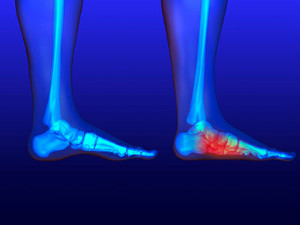 There are many people who experience flat feet, and a common sign is the absence of an arch at the bottom of the foot. There is an obvious way of recognizing flat feet, and this is generally observed when the foot is placed on the ground and noticing if the arch is present. Research has shown that most babies are born with flat feet and the arch will generally fully develop at approximately 6 years of age. The majority of people who have flat feet may not experience any discomfort, and this may not interfere with daily activities. Treatment may be necessary if certain symptoms are experienced, including difficulty in walking or maintaining balance, or if you feel pain or stiffness in your feet. If you are afflicted with flat feet, it’s advised to speak to a podiatrist who can offer suggestions on correct treatment options, which may include wearing supportive insoles or possible surgery.
There are many people who experience flat feet, and a common sign is the absence of an arch at the bottom of the foot. There is an obvious way of recognizing flat feet, and this is generally observed when the foot is placed on the ground and noticing if the arch is present. Research has shown that most babies are born with flat feet and the arch will generally fully develop at approximately 6 years of age. The majority of people who have flat feet may not experience any discomfort, and this may not interfere with daily activities. Treatment may be necessary if certain symptoms are experienced, including difficulty in walking or maintaining balance, or if you feel pain or stiffness in your feet. If you are afflicted with flat feet, it’s advised to speak to a podiatrist who can offer suggestions on correct treatment options, which may include wearing supportive insoles or possible surgery.
Flatfoot is a condition many people suffer from. If you have flat feet, contact Bruce Smit, DPM from Frankfort Foot & Ankle Clinic. Our doctor will treat your foot and ankle needs.
What Are Flat Feet?
Flatfoot is a condition in which the arch of the foot is depressed and the sole of the foot is almost completely in contact with the ground. About 20-30% of the population generally has flat feet because their arches never formed during growth.
Conditions & Problems:
Having flat feet makes it difficult to run or walk because of the stress placed on the ankles.
Alignment – The general alignment of your legs can be disrupted, because the ankles move inward which can cause major discomfort.
Knees – If you have complications with your knees, flat feet can be a contributor to arthritis in that area.
Symptoms
Treatment
If you are experiencing pain and stress on the foot you may weaken the posterior tibial tendon, which runs around the inside of the ankle.
If you have any questions please feel free to contact our office located in Frankfort, IL . We offer the newest diagnostic and treatment technologies for all your foot and ankle needs.
 Research has shown there are several differences between shoes made for walking and shoes to run in. The typical running shoe is generally constructed with added cushioning, which aids in promoting stability. Additionally, the soles may be thicker, which may cause potential trip hazards. There may be more sizes and colors to choose from in running shoes, which may make it easier to locate a comfortable pair. For serious walkers, it’s beneficial to purchase walking shoes that are designed to move the foot through the proper motion of walking. One significant difference in the styles of walking and running include runners landing flat-footed and walkers typically landing on their heels. If you are seriously considering pursuing either activity as a hobby, please consult with a podiatrist who can offer advice on which type of shoe is best for you.
Research has shown there are several differences between shoes made for walking and shoes to run in. The typical running shoe is generally constructed with added cushioning, which aids in promoting stability. Additionally, the soles may be thicker, which may cause potential trip hazards. There may be more sizes and colors to choose from in running shoes, which may make it easier to locate a comfortable pair. For serious walkers, it’s beneficial to purchase walking shoes that are designed to move the foot through the proper motion of walking. One significant difference in the styles of walking and running include runners landing flat-footed and walkers typically landing on their heels. If you are seriously considering pursuing either activity as a hobby, please consult with a podiatrist who can offer advice on which type of shoe is best for you.
For more information about walking shoes versus running shoes, consult with Bruce Smit, DPM from Frankfort Foot & Ankle Clinic. Our doctor can measure your feet to determine what your needs are and help you find an appropriate pair of footwear.
Foot Health: The Differences between Walking & Running Shoes
There are great ways to stay in shape: running and walking are two great exercises to a healthy lifestyle. It is important to know that running shoes and walking shoes are not interchangeable. There is a key difference on how the feet hit the ground when someone is running or walking. This is why one should be aware that a shoe is designed differently for each activity.
You may be asking yourself what the real differences are between walking and running shoes and the answers may shock you.
Differences
Walking doesn’t involve as much stress or impact on the feet as running does. However, this doesn’t mean that you should be any less prepared. When you’re walking, you land on your heels and have your foot roll forward. This rolling motion requires additional support to the feet.
Flexibility – Walking shoes are designed to have soft, flexible soles. This allows the walker to push off easily with each step.
If you have any questions, please feel free to contact our office located in Frankfort, IL . We offer the newest diagnostic and treatment technologies for all your foot care needs.
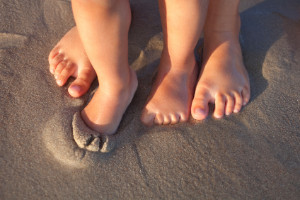 When babies are born, many first-time parents do not pay particular attention to their babies feet other than to notice how cute they are. Most babies feet are extremely flexible, and are constructed of several bones and joints with additional support coming from the ligaments. Twelve months of age is typically when most children begin to walk, and flat-footedness is a common condition among these new walkers. As their walking skills develop, the muscle strength will improve and a normal arch will develop. Toddlers will benefit by walking barefoot indoors as often as possible, which will allow the sole of the foot to touch the floor. This will aid in strengthening the tendons and ligaments in addition to the muscles of the foot. When the proper time comes for your child to wear shoes, it’s important to have their feet correctly measured. Please consult with a podiatrist if you would like additional information on how to care for your children’s feet.
When babies are born, many first-time parents do not pay particular attention to their babies feet other than to notice how cute they are. Most babies feet are extremely flexible, and are constructed of several bones and joints with additional support coming from the ligaments. Twelve months of age is typically when most children begin to walk, and flat-footedness is a common condition among these new walkers. As their walking skills develop, the muscle strength will improve and a normal arch will develop. Toddlers will benefit by walking barefoot indoors as often as possible, which will allow the sole of the foot to touch the floor. This will aid in strengthening the tendons and ligaments in addition to the muscles of the foot. When the proper time comes for your child to wear shoes, it’s important to have their feet correctly measured. Please consult with a podiatrist if you would like additional information on how to care for your children’s feet.
Making sure that your children maintain good foot health is very important as they grow. If you have any questions, contact Bruce Smit, DPM of Frankfort Foot & Ankle Clinic. Our doctor can provide the care you need to keep you pain-free and on your feet.
Keeping Children's Feet Healthy
Having healthy feet during childhood can help prevent medical problems later in life, namely in the back and legs. As children grow, their feet require different types of care. Here are some things to consider...
Although babies do not walk yet, it is still very important to take care of their feet.
Avoid putting tight shoes or socks on his or her feet.
Allow the baby to stretch and kick his or her feet to feel comfortable.
As a toddler, kids are now on the move and begin to develop differently. At this age, toddlers are getting a feel for walking, so don’t be alarmed if your toddler is unsteady or ‘walks funny’.
As your child gets older, it is important to teach them how to take care of their feet.
Show them proper hygiene to prevent infections such as fungus.
Be watchful for any pain or injury.
Have all injuries checked by a doctor as soon as possible.
Comfortable, protective shoes should always be worn, especially at play.
If you have any questions please feel free to contact our office located in Frankfort, IL . We offer the newest diagnostic and treatment technologies for all your foot and ankle needs.
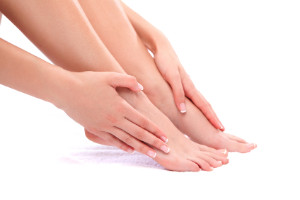 Many people are afflicted with several types of foot conditions, and these may be indicative of additional health issues that may be present in the body. Some people may experience muscle spasms and this may be a result of dehydration. If these spasms should occur while walking or running, it could be a symptom of a circulatory ailment. Additionally, a condition that is referred to as gout may be a result of excess uric acid that is present in the blood. Gout is a form of arthritis, which affects the big toe and typically produces extreme pain and discomfort. Patients who experience cold feet for the majority of the time may be aware that it may be a symptom of diabetes, thyroid concerns, or anemia. If you are experiencing any foot conditions, please consult with a podiatrist to learn how this may be a sign of other health issues.
Many people are afflicted with several types of foot conditions, and these may be indicative of additional health issues that may be present in the body. Some people may experience muscle spasms and this may be a result of dehydration. If these spasms should occur while walking or running, it could be a symptom of a circulatory ailment. Additionally, a condition that is referred to as gout may be a result of excess uric acid that is present in the blood. Gout is a form of arthritis, which affects the big toe and typically produces extreme pain and discomfort. Patients who experience cold feet for the majority of the time may be aware that it may be a symptom of diabetes, thyroid concerns, or anemia. If you are experiencing any foot conditions, please consult with a podiatrist to learn how this may be a sign of other health issues.
When dealing with systemic disease of the feet, it is extremely important to check the affected areas routinely so that any additional problems are caught quickly. If you have any concerns about your feet and ankles contact Bruce Smit, DPM from Frankfort Foot & Ankle Clinic. Our doctor will assist you with all of your podiatric needs.
Systemic Diseases of the Feet
Systemic diseases affect the whole body, and symptoms usually are displayed in the feet. This condition can make a patient’s ability to walk unbearable. Systemic diseases include gout, diabetes mellitus, neurological disorders, and arthritis.
Gout – is caused by an excess of uric acid in the body. Common symptoms include pain, inflammation, and redness at the metatarsal/phalangeal joint of the base big toe. Gout can be treated by NSAIDs to relieve pain and inflammation, and other drugs that lower the acid levels in the body.
Diabetes mellitus – is an increase in the level of blood sugar that the body cannot counteract with its own insulin. Failure to produce enough insulin is a factor in Diabetes.
Diabetes of the Feet
Diabetic Neuropathy – may lead to damaged nerves and affect the feet through numbness and loss of sensation.
Peripheral Vascular Disease – can restrict the blood flow to the feet, and often times lead to amputation of the feet.
If you have any questions please feel free to contact our office located in Frankfort, IL . We offer the newest diagnostic and treatment technologies for all your foot and ankle needs.
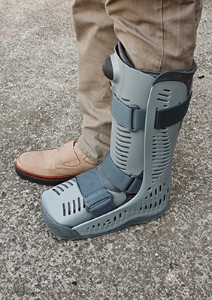 If you have ever experienced a broken ankle, you are most likely familiar with the severe pain and discomfort that is often associated with it. It may be difficult to differentiate between a fracture and a sprain due to the fact that most symptoms may be similar. These may include bruising, swelling, and the inability to walk because of the pressure the ankle must endure. For severely broken ankles, the bone may protrude from the skin and prompt treatment is recommended. An X-ray is typically performed to confirm if the ankle is broken or sprained. It’s suggested to consult with a podiatrist who can examine the broken ankle and discuss proper treatment options.
If you have ever experienced a broken ankle, you are most likely familiar with the severe pain and discomfort that is often associated with it. It may be difficult to differentiate between a fracture and a sprain due to the fact that most symptoms may be similar. These may include bruising, swelling, and the inability to walk because of the pressure the ankle must endure. For severely broken ankles, the bone may protrude from the skin and prompt treatment is recommended. An X-ray is typically performed to confirm if the ankle is broken or sprained. It’s suggested to consult with a podiatrist who can examine the broken ankle and discuss proper treatment options.
Broken ankles need immediate treatment. If you are seeking treatment, contact Bruce Smit, DPM from Frankfort Foot & Ankle Clinic. Our doctor can provide the care you need to keep you pain-free and on your feet.
Broken Ankles
A broken ankle is experienced when a person fractures their tibia or fibula in the lower leg and ankle area. Both of these bones are attached at the bottom of the leg and combine to form what we know to be our ankle.
When a physician is referring to a break of the ankle, he or she is usually referring to a break in the area where the tibia and fibula are joined to create our ankle joint. Ankles are more prone to fractures because the ankle is an area that suffers a lot of pressure and stress. There are some obvious signs when a person experiences a fractured ankle, and the following symptoms may be present.
Symptoms of a Fractured Ankle
If you suspect an ankle fracture, it is recommended to seek treatment as soon as possible. The sooner you have your podiatrist diagnose the fracture, the quicker you’ll be on the way towards recovery.
If you have any questions, please feel free to contact our office located in Frankfort, IL . We offer the newest diagnostic and treatment technologies for all your foot care needs.
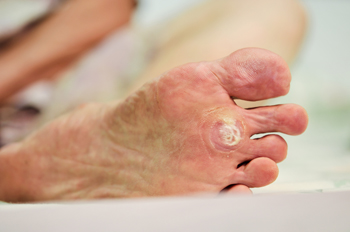 If you should develop a plantar wart, you may often be aware of the pain and discomfort that is associated with it. They are typically common warts, and form on the heel of the foot. The pain may be at it’s worse in the morning after rising, and may often feel like pieces of glass that have lodged in your heel. Research has shown that plantar warts originate from the human papillomavirus, and often lives and thrives in warm and moist places that may include locker and shower room floors, pools, and surrounding areas. It can typically enter the body thru small cracks in the sole of the foot and prevention of this virus may be accomplished by wearing appropriate shoes, while in these areas. There are several noticeable symptoms associated with this ailment, including a small and hardened round area appearing on the heel of the foot, possibly with black dots occupying the center. If you have developed a plantar wart, it’s suggested to seek counsel from a podiatrist as quickly as possible to begin the best course of treatment.
If you should develop a plantar wart, you may often be aware of the pain and discomfort that is associated with it. They are typically common warts, and form on the heel of the foot. The pain may be at it’s worse in the morning after rising, and may often feel like pieces of glass that have lodged in your heel. Research has shown that plantar warts originate from the human papillomavirus, and often lives and thrives in warm and moist places that may include locker and shower room floors, pools, and surrounding areas. It can typically enter the body thru small cracks in the sole of the foot and prevention of this virus may be accomplished by wearing appropriate shoes, while in these areas. There are several noticeable symptoms associated with this ailment, including a small and hardened round area appearing on the heel of the foot, possibly with black dots occupying the center. If you have developed a plantar wart, it’s suggested to seek counsel from a podiatrist as quickly as possible to begin the best course of treatment.
Plantar warts can be very uncomfortable. If you need your feet checked, contact Bruce Smit, DPM from Frankfort Foot & Ankle Clinic. Our doctor will assist you with all of your foot and ankle needs.
About Plantar Warts
Plantar warts are the result of HPV, or human papillomavirus, getting into open wounds on the feet. They are mostly found on the heels or balls of the feet.
While plantar warts are generally harmless, those experiencing excessive pain or those suffering from diabetes or a compromised immune system require immediate medical care. Plantar warts are easily diagnosed, usually through scraping off a bit of rough skin or by getting a biopsy.
Symptoms
Treatment
To help prevent developing plantar warts, avoid walking barefoot over abrasive surfaces that can cause cuts or wounds for HPV to get into. Avoiding direct contact with other warts, as well as not picking or rubbing existing warts, can help prevent the further spread of plantar warts. However, if you think you have developed plantar warts, speak to your podiatrist. He or she can diagnose the warts on your feet and recommend the appropriate treatment options.
If you have any questions please feel free to contact our office located in Frankfort, IL . We offer the newest diagnostic and treatment technologies for all your foot and ankle needs.
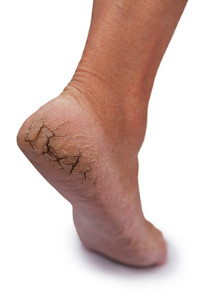 An uncomfortable and often painful foot condition known as cracked heels may occur for a variety of reasons. The most common cause is dry skin, which causes the cracks, also known as fissures, to develop. The skin may become dry for several reasons including standing for extended periods of time, specific skin conditions such as eczema, psoriasis, or athlete’s foot, and being overweight. An additional cause of cracked heels may come from wearing sandals that have an open back and these types of shoes may lack the support that is needed for healthy feet. If you have noticed that you have cracked skin on your heels, it’s suggested to wash the feet thoroughly followed by utilizing a good moisturizer, which may be more effective when used on damp skin. Please schedule a consultation with a podiatrist for a complete diagnosis in addition to discussing the best treatment options for you.
An uncomfortable and often painful foot condition known as cracked heels may occur for a variety of reasons. The most common cause is dry skin, which causes the cracks, also known as fissures, to develop. The skin may become dry for several reasons including standing for extended periods of time, specific skin conditions such as eczema, psoriasis, or athlete’s foot, and being overweight. An additional cause of cracked heels may come from wearing sandals that have an open back and these types of shoes may lack the support that is needed for healthy feet. If you have noticed that you have cracked skin on your heels, it’s suggested to wash the feet thoroughly followed by utilizing a good moisturizer, which may be more effective when used on damp skin. Please schedule a consultation with a podiatrist for a complete diagnosis in addition to discussing the best treatment options for you.
Cracked heels are unsightly and can cause further damage to your shoes and feet. If you have any concerns, contact Bruce Smit, DPM from Frankfort Foot & Ankle Clinic. Our doctor can provide the care you need to keep you pain-free and on your feet.
Cracked Heels
Cracked heels appear unappealing and can make it harder for you walk around in sandals. Aside from looking unpleasant, cracked heels can also tear stockings, socks, and wear out your shoes. There are several methods to help restore a cracked heel and prevent further damage.
How Do You Get Them?
Dry skin is the number one culprit in creating cracked heels. Many athletes, walkers, joggers, and even swimmers suffer from cracked heels. Age and skin oil production play a role to getting cracked heels as well.
Promote Healing
Over the counter medicines can help, especially for those that need instant relief or who suffer from chronic dry feet.
Wear Socks – Wearing socks with medicated creams helps lock in moisture.
Moisturizers – Applying both day and night will help alleviate dryness which causes cracking.
Pumice Stones – These exfoliate and remove dead skin, which allows for smoother moisturizer application and better absorption into the skin.
Change in Diet
Eating healthy with a well-balanced diet will give the skin a fresh and radiant look. Your body responds to the kinds of food you ingest. Omega-3 fatty acids and zinc supplements can also revitalize skin tissue.
Most importantly, seek professional help if unsure how to proceed in treating cracked heels. A podiatrist will help you with any questions or information needed.
If you have any questions, please feel free to contact our office located in Frankfort, IL . We offer the newest diagnostic and treatment technologies for all your foot care needs.
Read more about Solutions for Cracked Heels